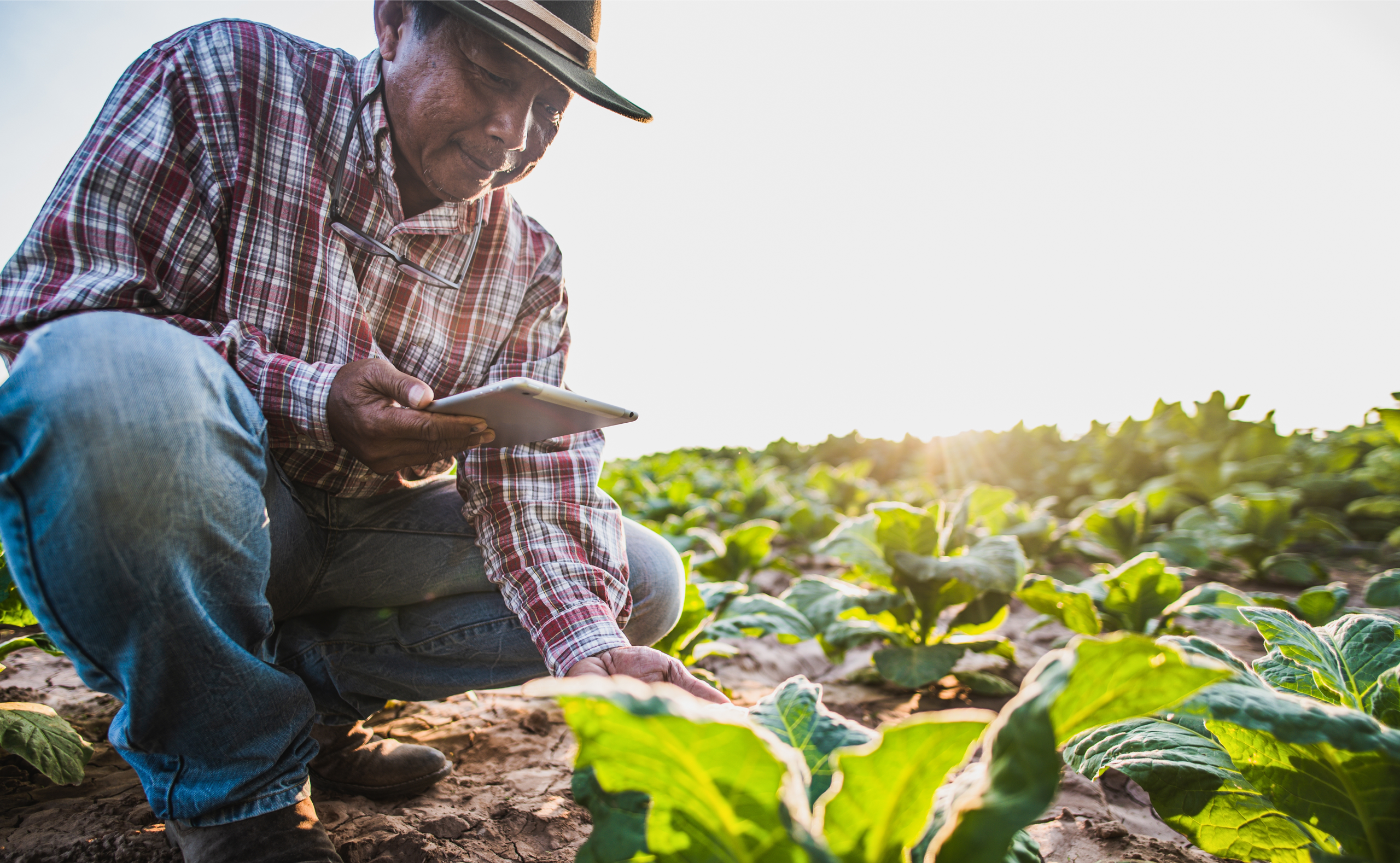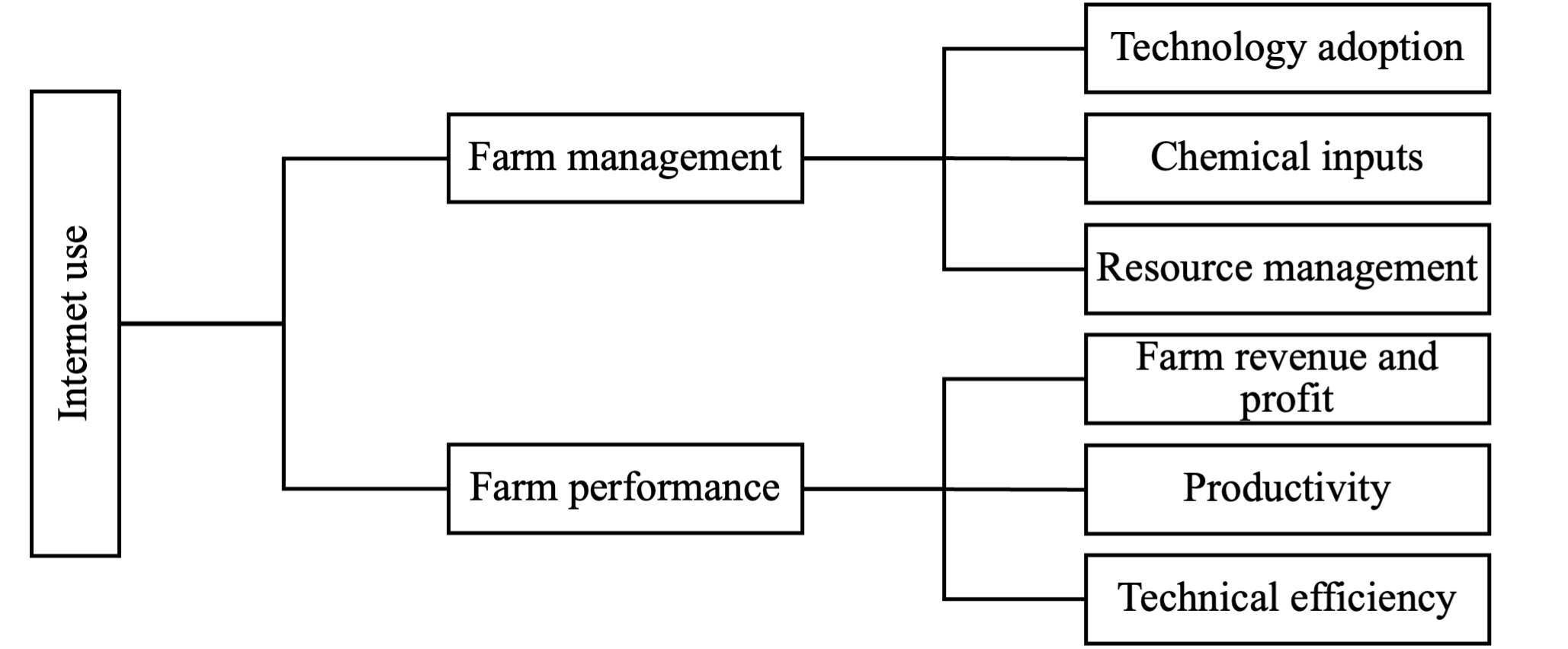
Internet access and use vary greatly across regions and countries. In 2023, the internet penetration rate, defined as the ratio of the number of internet users to the total population, was 65.9% in Asia and the Pacific but as high as 90.5% in European countries. Within Asia, internet penetration rates are relatively high in countries such as the Republic of Korea (97%), Japan (93.3%), and Singapore (92%). In contrast, countries like the Republic of China (PRC) (69.8%), India (59.5%), and Pakistan (50.9%) have comparatively lower internet penetration rates (Statista 2023). Globally, the internet penetration rate in rural areas has increased from 42.6% in 2020 to 50.4% in 2023, yet it still lags behind that of urban areas (ITU 2024).
Despite the relatively lower internet penetration rate in rural areas, the rapid expansion of internet use has significantly transformed and advanced the sustainability of agricultural production. Internet use fosters a more sustainable future for agriculture through two principal pathways: farm management and farm performance.
Internet Use and Sustainable Agricultural Production
Internet use can influence farm management and performance, eventually determining sustainable agricultural production (Figure 1).
Figure 1. Internet Use Impacts on Sustainable Agricultural Production

Source: Authors.
Improvements in Farm Management
The internet helps reduce information gaps and raises awareness about improved technologies, leading to higher adoption rates of improved agricultural technologies. Ma and Wang (2020) found that internet use in the PRC significantly improved the adoption of sustainable agricultural technologies and practices, such as organic fertilizer, water-saving technologies, soil testing, and integrated pest management. A study on India by Jarial (2023) reviewed the application of the Internet of Things (IoT), highlighting the positive role of the internet in facilitating the use of drones, robotics, precision irrigation, livestock tracking, and crop disease surveillance as examples of IoT applications.
Internet use has also affected the use of chemical inputs in farming. Access to online resources helps farmers optimize their input use. In Indonesia, Muis et al. (2023) demonstrated that internet access has a positive and statistically significant impact on chemical fertilizer use among small-scale sugarcane farmers. It also aids in minimizing natural resource extraction and provides farmers with opportunities for off-farm employment, decreasing the reliance on agricultural labor and, thus, reducing the extraction of natural resources. Meanwhile, Nguyen et al. (2022) found that internet use reduces the pressure on extracting natural resources in rural Thailand.
Improvements in Farm Performance
Internet use has been shown to enhance farm revenue and productivity. Khan et al. (2022) found that internet technology use significantly increases agricultural income and profit in Pakistan. By enabling farmers to obtain real-time market prices and best practices, internet use allows them to optimize their sales and production decisions.
Kaila and Tarp (2019) observed that internet access is associated with a 6.8% higher volume of total agricultural output in Viet Nam, highlighting the role of timely and accurate information in improving farming outcomes. Access to online resources and training programs allows farmers to better understand and implement efficient farming management strategies. Therefore, internet use has proven beneficial in improving technical efficiency (i.e., the effectiveness with which a given set of inputs is used to produce an output). A study by Zheng et al. (2021) on banana production in the PRC also revealed that internet use significantly improves technical efficiency, enhancing farm productivity and food security.
Barriers to Internet Use in Rural Asia
The findings from the existing literature highlight the positive role of internet use in promoting sustainable agricultural production. Consequently, one would expect rural residents to be highly inclined to use the internet. However, this expectation is contradicted by the reality that internet penetration rates in rural areas of developing Asian countries remain relatively low.
The demographic, socioeconomic, and institutional characteristics of farmers have been shown to influence their decisions to use the internet. For example, Nguyen et al. (2022) found that in Thailand, the internet use decisions of rural households are positively associated with the education level of household heads. Higher education means that rural households are better equipped to master internet use. Barbier (2023) emphasized the importance of household wealth as a socioeconomic factor in overcoming digital poverty traps among Asian farmers. Sufficient wealth enables the accumulation of human capital necessary for adopting digital technology. Additionally, rural households’ internet use decisions are influenced by institutional characteristics. For instance, Zheng et al. (2021) confirmed that access to extension agents and the distance to input markets are significant factors affecting the internet use decisions of banana farmers in the PRC.
Promoting Internet Use for Sustainable Agricultural Production
The development of internet use in rural areas worldwide has shown promising results in supporting sustainable agricultural production. Achieving this requires concerted efforts to improve internet accessibility, develop relevant digital tools, foster online communities, and integrate agricultural policies.
First, increasing the availability of broadband access is crucial for increasing the internet use penetration rate. Investments in rural information and communication technology infrastructure can ensure that even remote rural communities are connected to the digital world. Government policies should focus on subsidizing internet costs and providing digital training to enhance the adoption of internet-based devices.
Second, developing and disseminating agricultural applications (apps) tailored to local needs can significantly improve farmers’ knowledge of sustainable agriculture. For example, designing programs specifically aimed at improving the digital literacy of smallholder farmers and developing corresponding digital platforms is essential. These initiatives can help smallholder farmers escape digital poverty traps. Digital extension services can bridge the information gap and support sustainable farming practices.
Third, fostering a community of practice among farmers through online platforms can encourage peer learning and the sharing of best practices. As seen in the case of drought-tolerant wheat varieties, observing the success of neighboring farmers can motivate others to adopt similar technologies.
Finally, integrating internet use into broader agricultural policies can ensure a holistic approach to sustainable development. By supporting climate adaptation practices through digital means, governments can help farmers adopt sustainable methods. Moreover, policies encouraging digital tools for efficient resource management can further strengthen the resilience of rural agricultural systems.
References
Barbier, E. B. 2023. Overcoming Digital Poverty Traps in Rural Asia. Review of Development Economics 27: 1403–1420.
ITU. 2024. ITU Releases 2023 Internet Use Estimates.
Jarial, S. 2023. Internet of Things Application in Indian Agriculture, Challenges and Effect on the Extension Advisory Services – A Review. Journal of Agribusiness in Developing and Emerging Economies 13: 505–519.
Kaila, H., and F. Tarp. 2019. Can the Internet Improve Agricultural Production? Evidence from Viet Nam. Agricultural Economics 50: 675–691.
Khan, N., R. L. Ray, S. Zhang, E. Osabuohien, and M. Ihtisham. 2022. Influence of Mobile Phone and Internet Technology on Income of Rural Farmers: Evidence from Khyber Pakhtunkhwa Province, Pakistan. Technology in Society 68, 101866.
Ma, W., and X. Wang. 2020. Internet Use, Sustainable Agricultural Practices and Rural Incomes: Evidence from China. Australian Journal of Agricultural and Resource Economics 64: 1087–1112.
Muis, A., S. Wulandari, I. K. Ardana, and A. Wahyudi. 2023. Understanding Climate Adaptation Practices Among Small-Scale Sugarcane Farmers in Indonesia : The Role of Climate Risk Behaviors, Farmers’ Support Systems, and Crop-Cattle Integration. Resources, Environment and Sustainability 13, 100129.
Nguyen, T. T., T. T. Nguyen, and U. Grote. 2022. Internet Use, Natural Resource Extraction and Poverty Reduction in Rural Thailand. Ecological Economics 196, 107417.
Statista. 2023. Internet Penetration in Asia as of July 2022, by Country or Territory.
Zheng, H., W. Ma, F. Wang, and G. Li. 2021. Does Internet Use Improve the Technical Efficiency of Banana Production in China? Evidence from a Selectivity-Corrected analysis. Food Policy 102, 102044.









Comments are closed.